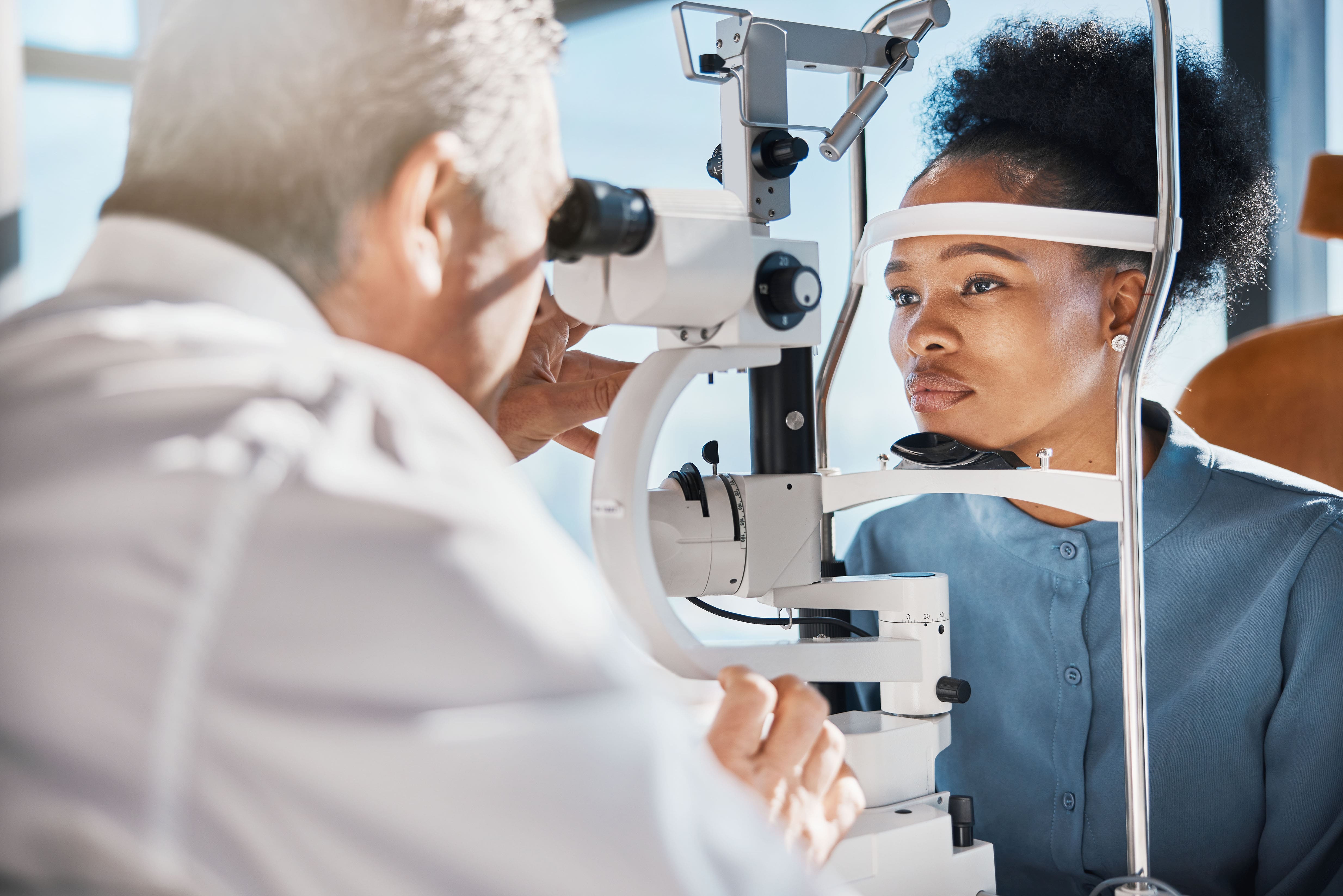Updated on September 24, 2024
Buying Non-Prescription Colored Contacts Safely


Vision Center is funded by our readers. We may earn commissions if you purchase something via one of our links.
Why are Non-Prescription Colored Contacts Illegal?
In the US, selling all types of contacts to people without a valid prescription is illegal. This is because the FDA classifies all contact lenses as medical devices.
A prescription from an eye doctor is necessary for all contact lens purchases. This also applies to contacts that are not used for vision correction.
Your eye doctor will examine your eyes and then write you a prescription, even if you have normal vision.
Some companies that sell colored contacts may use unsafe materials in their products. You should only buy FDA-approved contact lenses to ensure you don't put yourself at risk.
Prescription vs. Non-Prescription Colored Contacts
Prescription-colored contacts come with a prescription label on them. They can correct vision problems like myopia, hyperopia, or astigmatism.

These contacts also change your eye color when worn. They're made out of safe materials and fit snugly into your eyes.
On the other hand, non-prescription colored contacts are sold over the counter. They only change your eye color and don't correct vision problems. These lenses aren't FDA-regulated, so they could contain harmful chemicals.
Purchasing and wearing these lenses can lead to serious health risks. If you wear colored contacts, make sure you get a prescription from an eye doctor first.
Best Colored Contacts
Non-prescription colored contacts are illegal in the United States. These colored contact lenses are also called cosmetic, decorative, or costume lenses and are available through a prescription from an eye doctor.
Non-prescription colored contacts are soft contacts made from a silicone hydrogel material. People have used them for decades in movies and fashion shoots because they can change your eye color or even the shape of your pupil.


Non-prescription colored contacts have gained mainstream popularity as part of Halloween costumes, cosplay, photoshoots, or everyday aesthetic purposes.
If you have questions about how to get colored non-prescription contact lenses, visit 1-800 Contacts to learn more.
Are Fake Contact Lenses Safe?
Any contact brand that does not require a prescription is not safe.
Colored contacts that claim to be a “one-size-fits-all” product can cause severe eye damage. Eyes have different sizes and curvatures, so you need a professional contact lens fitting from an eye doctor.
Plenty of verified brands sell colored contacts through a prescription from your eye doctor. If you visit an eye care professional for a fitting, you will wind up with a safe product.
We Recommend Air Optix Colors for colored contact wearers.

What are the Dangers of Fake Contact Lenses?
All types of contact lenses are medical devices. There is a risk of irritation and infection, even when wearing prescription lenses. Fake contact lenses present even bigger risks, including:
Corneal Scratches
Corneal scratches occur when the lenses move around in your eye and cause friction. This can create tiny cuts or abrasions on the surface of the cornea. These scratches can be painful and lead to infection if left untreated.
Conjunctivitis (pink eye)
Conjunctivitis is a common eye infection caused by bacteria. Fake contact lenses make it easier for bacteria to enter your eye, leading to infection. Symptoms include redness, swelling, and itching of the eyes.
Corneal Infection
Since bacteria can easily enter your eye through fake lenses, you may be at risk for corneal infection. Symptoms of a corneal infection include red eyes, blurred vision, light sensitivity, pain, and swelling. In severe cases, it can even cause blindness.
Cornea Ulcers
A corneal ulcer is an open sore on the cornea. Infections from wearing fake contact lenses can cause this.
Decreased Vision
When you wear fake contact lenses, you may experience decreased vision. This is because the lenses may not be designed for optical clarity, and they may also cause issues that impair your vision.
Illegal Colored Contacts May be Toxic
In some cases, fake contact lenses can also be toxic. They may contain chemicals that can cause permanent damage to your eyes. Since these lenses are sold illegally, it can be hard to know what they contain.
Where to Buy Colored Contact Lenses
If you're going to buy non-prescription colored contacts, you can buy from trusted retailers online or directly from your doctor's clinic. You should only buy FDA-approved contact lenses from reputable shops.
Avoid buying contacts from:
- Beauty supply stores or salons
- Convenience stores
- Groceries
- Flea markets
- Novelty or boutique stores
- Online retailers that don't require a prescription
Note: Once you get a contact lens fitting and a prescription card from your ophthalmologist, you can order non-prescription colored contacts online from retailers like 1-800 Contacts.
Can I Get Prescription Colored Contacts?
You can get prescription colored contacts if you already have a valid contact lens prescription. If you don't have one, you can schedule a contact lens fitting with an eye doctor.

You can also visit 1-800 Contacts for more information.
What to Expect at a Contact Lens Fitting
If you want to wear non-prescription colored contacts, you'll need to get a fitting from an eye doctor. Here's what you can expect from a professional lens fitting:
1. The Doctor Will Perform Several Tests
These tests will determine if your eyes are healthy. If they are, they can recommend contact lenses that fit your lifestyle and budget.
2. You Will Receive a Comprehensive Eye Exam
A doctor may give you a comprehensive eye exam, especially if you haven't received one recently. This exam will determine your contact lens prescription.
They will measure your corneal curvature and eyeball shape. If you have astigmatism, your eyes won't be perfectly rounded, and you may need toric lenses.
Your eye doctor may also measure your pupil and iris size. They can also possibly do a tear film evaluation test.
3. The Doctor Will Give Their Recommendation
Once the necessary information has been gathered, your doctor will be able to provide their recommendation for the specific type of contact lens you can wear.
They will also show you how to insert and remove your lenses and instruct you on wearing and storing your contacts. Usually, you will be scheduled for a follow-up appointment in a week or so to see how the contact lenses fit you.
How to Wear Colored Contacts Safely
To wear colored lenses safely, follow the instructions provided by your eye doctor and wear them exactly as prescribed.
Every set of contacts will have several days to be worn before being replaced. This ranges from one to 90 days. Never wear your contacts longer than recommended, as you risk getting an infection.
Follow these steps to put contacts in safely and comfortably:
- Wash your hands with soap and water. Because you’re putting your finger in your eye, you want to ensure it’s clean. Non-perfumed, antibacterial liquid soap is best.
- Make sure you’re holding the contact the right way. It’s easy to confuse which side touches your eye. Put the contact on your dominant hand's index finger or middle finger. Make sure that it looks like a little bowl. (If it doesn’t, it’s probably inside out). Some lenses have a 1, 2, or 3 indicator; ensure these digits are not backward.
- Hold your eye open with one hand. Hold your upper eyelid open and tug your lower eyelid down. This prevents you from blinking. You also don’t want to get any eyelashes caught under your contact.
- Place the contact with the other hand. With your other hand, steadily raise the tip of your finger that’s holding the contact to your eye.
- Look upward. As you place the contact in your eye, look upward. You’ll want to place the contact on your eye gently.
- Close your eye. After placing the contact, slowly release your eyelids and close your eye. Let the contact settle for a moment before opening your eye.
- Repeat for your other eye. Repeat steps one through six for your other eye.
Always wash your hands before inserting, removing, or cleaning your contacts. Hygiene is of the utmost importance in maintaining proper eye health.
Summary
Non-prescription contact lenses are illegal in the United States. It's important to visit your eye doctor for a professional fitting and follow their instructions. This ensures you'll be wearing your contacts safely and comfortably.
What's Next?
In this article
6 sources cited
Updated on September 24, 2024
Updated on September 24, 2024
About Our Contributors
Michael, a lead content writer for Vision Center, brings eight years of experience in medical copywriting and advanced research methodologies. With a B.A. in English and Linguistics from the University at Buffalo, he specializes in creating detailed, evidence-based content, particularly in the field of eye health, to educate readers and guide them toward appropriate treatments.
Dr. Melody Huang is an optometrist and freelance health writer with a passion for educating people about eye health. With her unique blend of clinical expertise and writing skills, Dr. Huang seeks to guide individuals towards healthier and happier lives. Her interests extend to Eastern medicine and integrative healthcare approaches. Outside of work, she enjoys exploring new skincare products, experimenting with food recipes, and spending time with her adopted cats.






